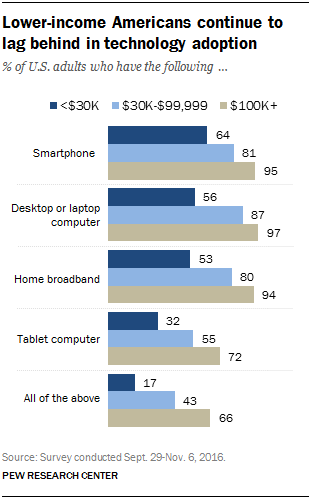 |
We often hear the worry that libraries are becoming obsolete
with the internet and digital access we have at home these days. But in the Palomar Library and Information Technology program, I’ve found that the opposite
is true. The digital age is showcasing
how good libraries adapt according to the needs of the community it serves.
 In an article on the digital divide, Kathy Koch quotes David
Boaz, executive vice president of the libertarian Cato Institute, on the future
of this divide. Back in 1999 Boaz said, “It
is sheer scare-mongering to write reports about information haves and have-nots.
The reality is a little less exciting: the have-nows and have-laters” (2000).
In an article on the digital divide, Kathy Koch quotes David
Boaz, executive vice president of the libertarian Cato Institute, on the future
of this divide. Back in 1999 Boaz said, “It
is sheer scare-mongering to write reports about information haves and have-nots.
The reality is a little less exciting: the have-nows and have-laters” (2000).
 In an article on the digital divide, Kathy Koch quotes David
Boaz, executive vice president of the libertarian Cato Institute, on the future
of this divide. Back in 1999 Boaz said, “It
is sheer scare-mongering to write reports about information haves and have-nots.
The reality is a little less exciting: the have-nows and have-laters” (2000).
In an article on the digital divide, Kathy Koch quotes David
Boaz, executive vice president of the libertarian Cato Institute, on the future
of this divide. Back in 1999 Boaz said, “It
is sheer scare-mongering to write reports about information haves and have-nots.
The reality is a little less exciting: the have-nows and have-laters” (2000).
Monica Anderson, in her post Digital divide persists even as lower-income Americans make gains in tech adoptions, showcases how wrong his prediction
was. Though more people have access to technology, there is still a significant
gap today. One major roles that libraries play in this digital age is to
help bridge those gaps in access. The American Library Association has an
office for outreach for diversity, literacy, and outreach services. They work to bring access to knowledge and
services for these groups:
- Adult New and Non-Readers
- Gay, Lesbian, Bisexual and Transgender People
- Incarcerated People and Ex-Offenders
- Older Adults
- People of Color
- People with Disabilities
- People Experiencing Poverty and Homelessness
- Rural, Native and Tribal Libraries
- Bookmobile Communities
There are
many examples of libraries working to close this gap and increase the knowledge
and service for these marginalized groups.
There is an award, LibraryAware Community Award, which highlights
libraries that are working to improve communities including digital access,
adaptation and literacy.
There are examples
of libraries doing exceptional work looking beyond the typical library programs
to find needs in the community and fill them. In Berry’s (2017) Library Journal
article she highlighted the 2017 winners of the LibraryAware award. I found the Cawtaba County Library example of
how a library used a community assessment to work with members and
organizations in that community to help fill needs. Because of the input, the library added a
full time digital services librarian and a “Big Read Program” turned into a
Spanish book club which helped highlight the need for better Spanish materials
and due to that there was increased patronage from the Spanish community (pg.
27).
There is no
need to worry about libraries becoming outdated or no longer needed as the digital age speeds up. As long as there is a community with needs,
there will be libraries working to fill those needs.
Resources
American
Library Association. (2008, September 6). Outreach to Underserved Populations.
Retrieved from http://www.ala.org/advocacy/diversity/outreachtounderservedpopulations
Anderson,
M. (2017, March 22). Digital divide
persists even as lower-income Americans make gains in tech adoption.
Retrieved from http://www.pewresearch.org/fact-tank/2017/03/22/digital-divide-persists-even-as-lower-income-americans-make-gains-in-tech-adoption/
Berry, J.
N. (2017). Finding and Filling Needs. (Cover story). Library Journal, 142(6),
26-29.
Koch,
K. (2000, January 28). The digital divide. CQ Researcher, 10, 41-64. Retrieved
from http://library.cqpress.com/

No comments:
Post a Comment